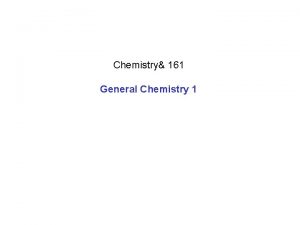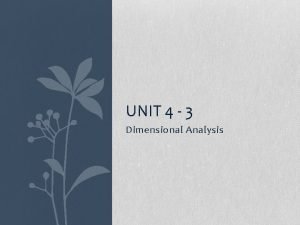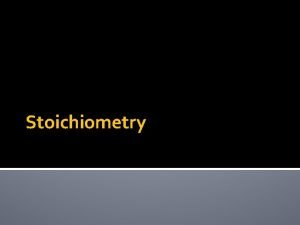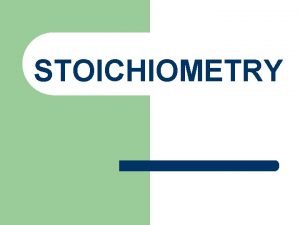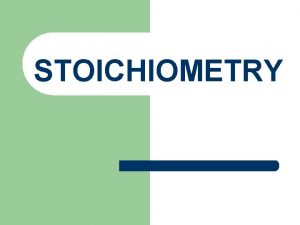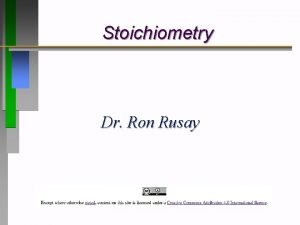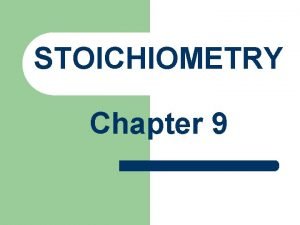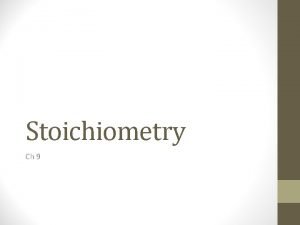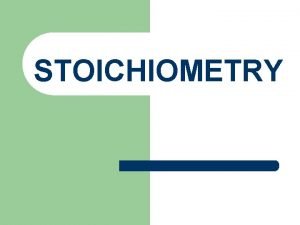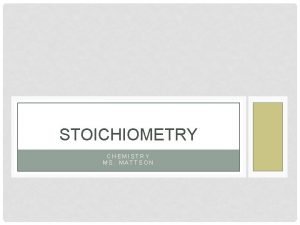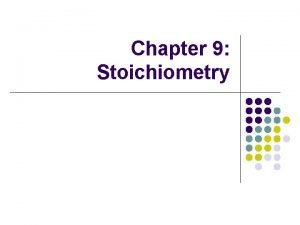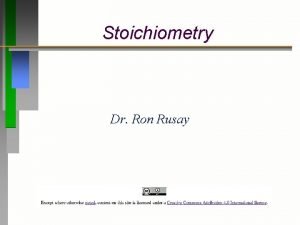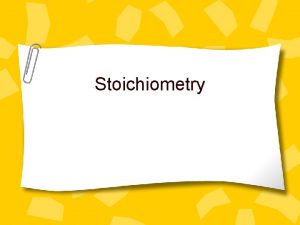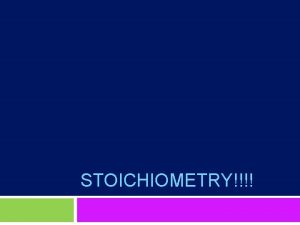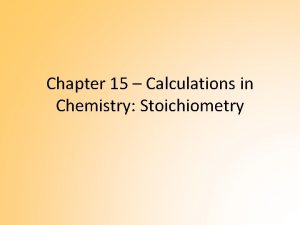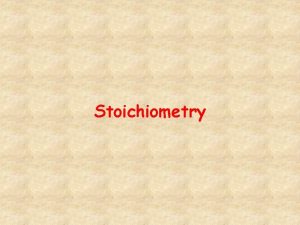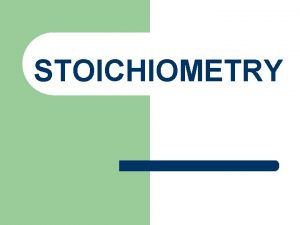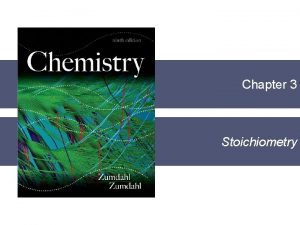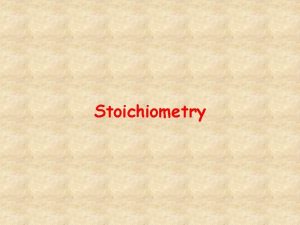Unit 7 Stoichiometry General Info Stoichiometry is the
























- Slides: 24

Unit 7 Stoichiometry

General Info • Stoichiometry is the quantitative relationships between the amounts of reactants used and the amounts of products formed by a chemical reaction. It is “Chemistry Accounting. ” • Starting quantities of a reactant or product may be given in moles, grams, number of particles/molecules or Liters of gas. These quantities are then used to calculate the amount of another substance involved in the chemical reaction. • Dimensional analysis (also known as the Factor Label Method) is most commonly used to solve stoichiometry problems and involves setting up a series of conversion factors dependent on units and known equalities to solve for an unknown. • It is very important that units are included with all values in a calculation to ensure a proper set-up.

BEGINNING STEPS FOR SOLVING STOICHIOMETRY PROBLEMS • For all stoichiometry calculations, start with the chemical equation for the reaction being discussed. • Write the chemical equation showing the reactants on the left side of the arrow and the products on the right side of the arrow. • You may be given the equation or you may be given a word equation that describes the chemical reaction. • If a word equation is given, you will need to write the formulas for the reactants and products using the rules for naming ionic and covalent compounds and for determining the ratio of ions in an ionic compound. Reference notes from Units #4 and #5/#6 for this. • Then, balance the chemical equation

SOLVING DIFFERENT TYPES OF STOICHIOMETRY PROBLEMS MOLESA MOLESB CONVERSIONS 1. The quantity given is moles and the quantity asked for is moles. 2. Coefficients of the balanced equation represent the moles of each substance in the reaction and are used in the conversion factor. 3. Sequence for solving is Moles. A Moles. B


MASSA MASSB CONVERSIONS 1. The quantity given is mass in grams and the quantity asked for is mass in grams. 2. Coefficients of the balanced equation and molar masses of each substance involved are used in the conversion factors 3. Sequence for solving is Mass. A Moles. A Moles. B Mass. B


Let’s Try This Example Together! • Cu + 4 HNO 3 Cu(NO 3)2 + 2 H 2 O + 2 NO 2 • Problem: What is the total mass of H 2 O produced when 384 g Cu is completely consumed? • Given: Mass A, 384 g Cu • Asked For: Mass B, g HCO • Use Mass. A Moles. A Moles. B Mass. B

Let’s try this example together!

Particles. A Particles. B Conversion 1. The quantity given is particles/molecules and the quantity asked for is particles/molecules. 2. The coefficients of the balanced equation and Avogadro’s number (1 mo. Ie=6. 02 x 10 23 particles) are used in the conversion factors. 3. Sequence for solving is Particles. A Moles. A Moles. B Particles. B



Volume. A Volume. B Conversion 1. The quantity given is Liters of gas at standard temperature and pressure (STP) and the quantity asked for is Liters of gas. 2. The coefficients of the balanced equation and the equality 22. 4 Liters/1 Mole of any gas at STP are used in the conversion factors. 3. The sequence for solving is Volume. A Mo. Ies. A Moles. B Volume. B



Mixed Problems: • Other Stoichiometric Problems used the same conversion factors as listed previously, but can include: • Mass. A Moles. B • Moles. A Mass. B

Percent Yield and Limiting Reactants Important Formula!! % Yield = actual yield x 100% theoretical yield

Percent Yield • Actual yield is the actual amount of a substance that is produced in a lab and can be expressed in grams or moles. • Theoretical yield is the amount of a substance that should be produced according to the stoichiometry calculation and can be expressed in grams or moles. • % Yield = actual yield x 100% theoretical yield • Super important to note: whichever measurement you choose has to be the same for both actual and theoretical yields in order for your answer to be accurate

Example:

Example:

Limiting Reactants • Chemical reactions are limited by the amount of reactants available to produce product. • A limiting reactant is the reactant that is completely consumed during a chemical reaction. Reactants that remain after the reaction has stopped are called excess reactants. • To determine the limiting reactant, the moles of reactants available must be calculated (if not given). Then, using the coefficients of the balanced equation, the amount of each reactant required to react completely must be compared to what’s available. • The amount of product produced is calculated using the quantity of reactant determined to be limiting.



 Unit 10, unit 10 review tests, unit 10 general test
Unit 10, unit 10 review tests, unit 10 general test General chemistry 1 stoichiometry
General chemistry 1 stoichiometry Unit: stoichiometry “multi-step problems” – ws #3
Unit: stoichiometry “multi-step problems” – ws #3 Hình ảnh bộ gõ cơ thể búng tay
Hình ảnh bộ gõ cơ thể búng tay Slidetodoc
Slidetodoc Bổ thể
Bổ thể Tỉ lệ cơ thể trẻ em
Tỉ lệ cơ thể trẻ em Gấu đi như thế nào
Gấu đi như thế nào Tư thế worm breton là gì
Tư thế worm breton là gì Hát lên người ơi alleluia
Hát lên người ơi alleluia Môn thể thao bắt đầu bằng chữ f
Môn thể thao bắt đầu bằng chữ f Thế nào là hệ số cao nhất
Thế nào là hệ số cao nhất Các châu lục và đại dương trên thế giới
Các châu lục và đại dương trên thế giới Công của trọng lực
Công của trọng lực Trời xanh đây là của chúng ta thể thơ
Trời xanh đây là của chúng ta thể thơ Mật thư tọa độ 5x5
Mật thư tọa độ 5x5 Làm thế nào để 102-1=99
Làm thế nào để 102-1=99 độ dài liên kết
độ dài liên kết Các châu lục và đại dương trên thế giới
Các châu lục và đại dương trên thế giới Thể thơ truyền thống
Thể thơ truyền thống Quá trình desamine hóa có thể tạo ra
Quá trình desamine hóa có thể tạo ra Một số thể thơ truyền thống
Một số thể thơ truyền thống Cái miệng bé xinh thế chỉ nói điều hay thôi
Cái miệng bé xinh thế chỉ nói điều hay thôi Vẽ hình chiếu vuông góc của vật thể sau
Vẽ hình chiếu vuông góc của vật thể sau Thế nào là sự mỏi cơ
Thế nào là sự mỏi cơ

